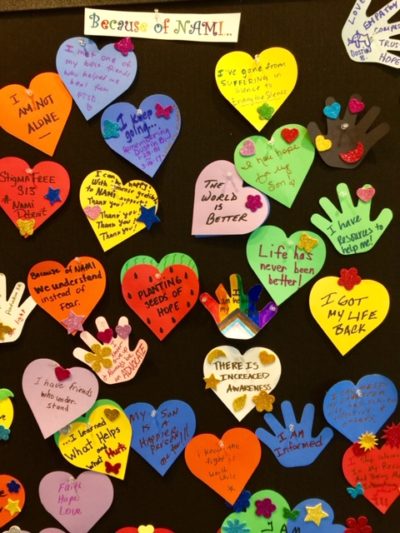
(7-1-19) Long-time NAMI advocate Bob Carolla returned from the organization’s 2019 convention with this report. Full disclosure: I am a life time member of NAMI and support it monthly.
NAMI’s Convention: Our Movement, Our Time: A report by Bob Carolla
The National Alliance on Mental Illness (NAMI) celebrated the 40th anniversary of its founding at its national convention in Seattle, June 19-22.
Twenty years ago, I remember vividly that there was a sense that the mental health community was on the verge of a new horizon—a next level. The landmark U.S. Surgeon General’s Report on Mental Health had just been published; it framed mental health and mental illness as parts of a single continuum, identified “parity” between physical and mental health insurance benefits as a critical need, and made stigma a public health issue. The Academy Award-winning movie A Beautiful Mind was in the works.
Change comes incrementally.
It’s often hard to see at any one moment in time. But in the past 20 years there has been more progress than many of us realize. There have been advances in medical research, greater public awareness and openness about mental health conditions, enactment of a national parity law, state expansions of Medicaid and a growing focus on early intervention and prevention.
There is still much work to be done, but I believe we are again on the verge of a new horizon—a next level with more progress.
Like the rest of the country, NAMI and others in the mental health organizations are experiencing generational changes. New technology, new leaders, new structures and new alliances are starting to emerge. We may not be able to see it yet, but I feel it, as surely as I felt the beginning of recovery and renewal after being diagnosed with bipolar depression 25 years ago.
Three Priorities, Three Tracks
In Seattle, NAMI launched a strategic plan for 2020-2025, setting three overarching goals: to ensure that people get help early for mental health conditions, that they get the best possible care, and that they are diverted from the criminal justice system.
The convention had plenary sessions, workshops and special events reflecting those priorities, organized along three tracks: personal change, societal change, systems change. There were about 60 topics overall. The challenge was for a person to pick and choose ones that fit their personal interests and needs—and to bring inspiration and knowledge home to benefit themselves, their loved ones and their communities. (Power Point slides of some sessions are available on NAMI’s website. A non-affiliated vendor sells CD and MP3 audio recordings)
HHS Assistant Secretary: More Power Than You Know
The nation’s first high-level HHS Assistant Secretary for Mental Health, Dr. Elinore McCance-Katz, opened the convention through a conversation with NAMI Acting CEO Angela Kimball. Mental health reform legislation enacted in 2016 created her position, which oversees the federal Substance Abuse & Mental Health Services Administration (SAMHSA). Along with an increase of $6 billion in SAMHSA’s budget, Dr. McCance-Katz described SAMHSA’s shifts in focus to early intervention and evidence-based, integrated treatment—along with increased attention to eating disorders and suicide prevention. She also said that diversion of people from the criminal justice system is “a major reason I took the job.”
A key to progress will be expansion of the mental health work force, through higher salaries, better training, and greater use of nurse practitioners, peer specialists, and telehealth. It will require increased, stable investments by government, private industry and a broader range of professions—including schools. It’s a tall order, requiring even greater grassroots advocacy, in which NAMI has always had a leading role. “You can be more powerful than you know,” she said.
Criminal Justice, Personal Highs
NAMI’s priority for diversion from the criminal was evident in much of the convention program. Workshop topics and discussions included “Narrowing the Net,” “Solving the Competency Dilemma,” “The Destructive Impact of Solitary Confinement” and “Celebrating Advancements: When the Judiciary Joins the Conversation.”
Other topics included new research, whole health approaches to treatment and recovery, how to challenge insurance company denials, cognitive behavioral therapy (CBT), inpatient care, assertive community treatment (ACT), digital mental health, family navigation of school and mental health care systems, veterans, African American churches, multicultural awareness, NAMI college chapters and engaging young adults.
An emotional high point came during a screening and panel discussion of the “raw and unflinching” documentary “Bipolar Rock n’ Roller” with Mauro Ranallo, a World Wrestling Entertainment (WWE) combat sports announcer for Showtime’s Championship Boxing–a macho sport viewed by millions of people, among whom the stigma of mental illness is considered strongly rooted. Another was the talk, “Dear Stranger: A Journey of Youth Mental Health,” by Diana Chao, age 20, who was diagnosed with bipolar disorder at age 13 and has since launched Letters to Strangers (L2S) the only multilateral youth-run, youth-to youth non-profit mental health organization in the world.
Schizophrenia: Early Intervention & Recovery
Dr. Robert Heissen, chief of the National Institute of Mental Health’s Division of Services & Intervention Research summarized findings from its 2008 RAISE Study and the development of Coordinated Specialty Care (CSC) programs—in which NAMI has been extensively involved. Ten years ago, only Oregon had early intervention programs; the number has expanded to 12 states, with 265 programs overall (see slide presentation). Thanks to NAMI’s advocacy, 10 percent of federal mental health block grant funds must now be dedicated to early intervention. One take-way: grassroots advocates need to ask local mental health clinics whether they offer CSC programs. If not, ask why not, and what can we do to make it happen?
Dr. Heissen also heralded a recent Advancing Discovery Summit convened by NIMH, NAMI, the Stanley Center for Psychiatric Research at Broad Institute and the Foundation for the National Institutes of Health, to consider a potential public-private partnership to promote greater investment and coordination of research on the root causes, progression and treatment of schizophrenia.
Coming Home: Reflection
By plane, it was a four-to five hour trip home from Seattle, about 2,300 miles. Time and distance. Thinking back 40 years, then 20 years, then 10, progress has been made. Very slowly perhaps, but surely. Where will mental health care be in five more years—as a result of NAMI’s new strategic plan? Where will it be in 10 years, in 2029, when NAMI reaches its 50th anniversary milestone, coinciding with the 30th anniversary of the Surgeon General’s landmark report? I’m a big believer in the power of anniversaries: they stir up memories, good or bad, and can have renewed impacts. In the face of a fragmented, sorely lacking mental health care system, it is easy to become discouraged, skeptical, or even cynical. However, the spiritual core of NAMI and the rest of our movement is love and hope. We may sometimes feel pessimistic, but we have an obligation of optimism.
ABOUT THE AUTHOR: Bob Carolla served on NAMI’s national communications staff from 1998 to 2017. He is on the editorial board of BP magazine and was recently appointed to Arlington County, Virginia’s Community Services Board.




